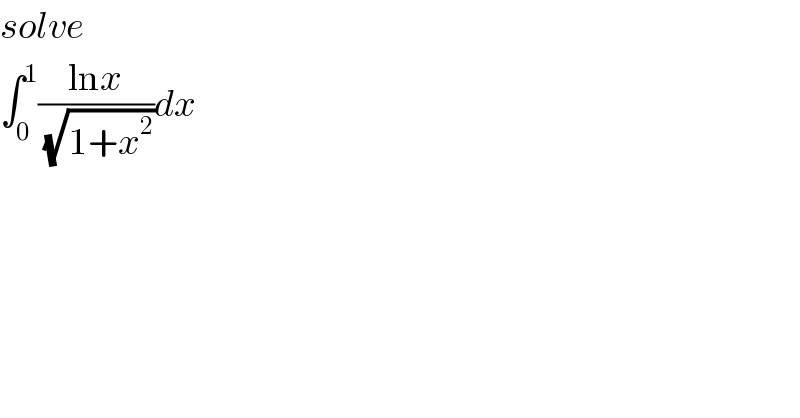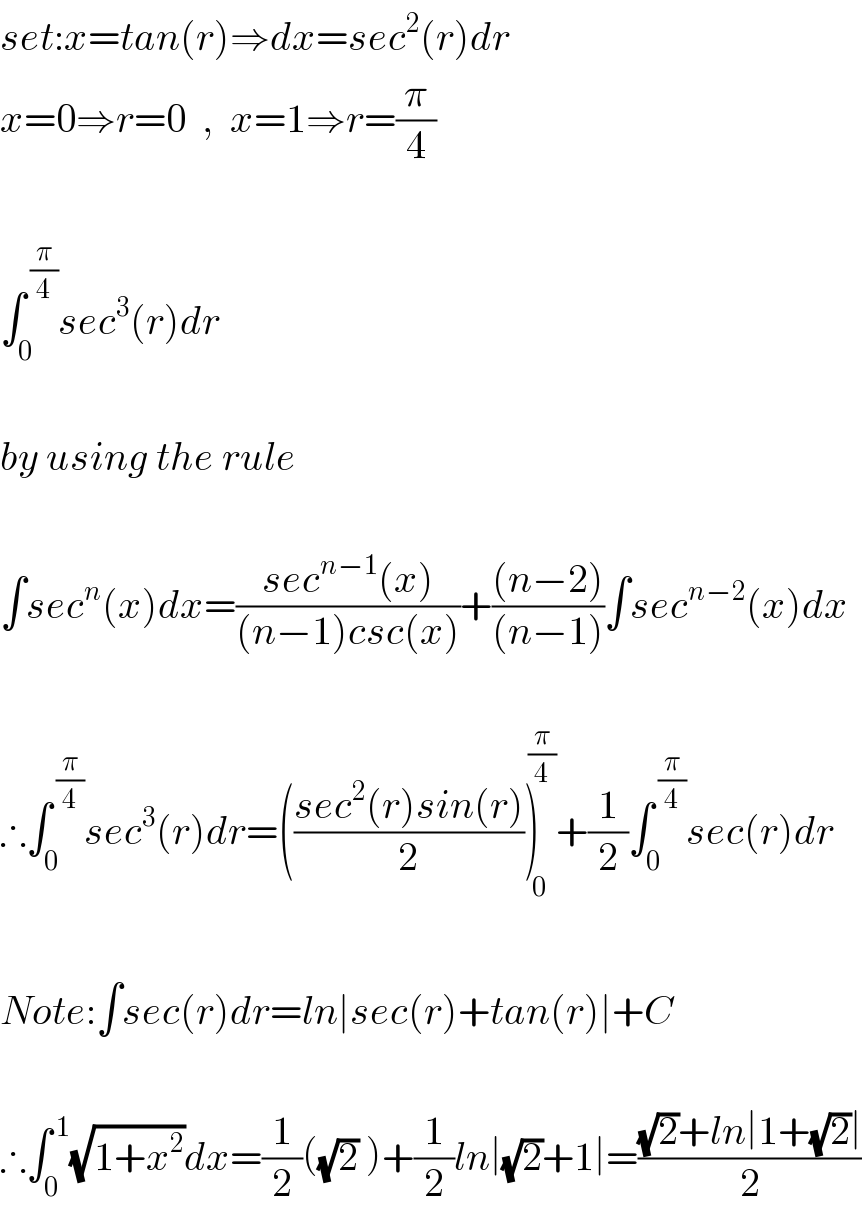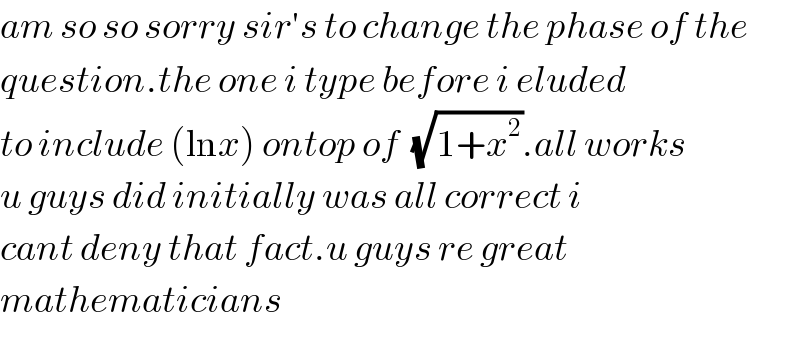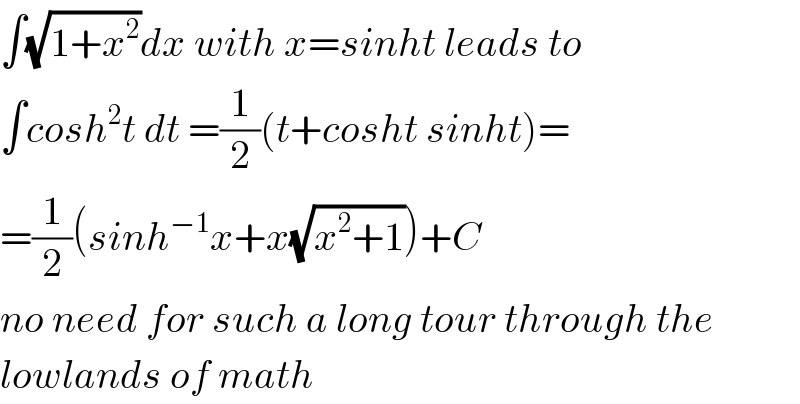
Question and Answers Forum
Question Number 112313 by mathdave last updated on 07/Sep/20

Commented by mohammad17 last updated on 07/Sep/20

Commented by mathdave last updated on 07/Sep/20

Answered by Dwaipayan Shikari last updated on 07/Sep/20
![[(x/2)(√(1+x^2 ))+(1/2) log(x+(√(x^2 +1)))]_0 ^1 =(1/( (√2)))+(1/2)log(1+(√2))](Q112314.png)
Answered by MJS_new last updated on 07/Sep/20
![∫_0 ^1 (√(x^2 +1))dx= [t=x+(√(x^2 +1)) → dx=((√(x^2 +1))/(x+(√(x^2 +1))))dt] =∫_1 ^(1+(√2)) ((t/4)+(1/(2t))+(1/(4t^3 )))dt= =[(t^2 /8)+((ln t)/2)−(1/(8t^2 ))]_1 ^(1+(√2)) =(((√2)+ln (1+(√2)))/2)](Q112335.png)
Answered by mathdave last updated on 07/Sep/20
![solution to ∫_0 ^1 ((lnx)/(√(1+x^2 )))dx let x=sinhθ,dx=coshθdθ and sinh^(−1) (x)=ln(x+(√(1+x^2 ))) I=∫_(sinh^(−1) (0)) ^(sinh^(−1) (1)) ((ln(sinhθ))/(coshθ))dθ=∫_0 ^(sinh^(−1) (1)) ln(sinhθ)dθ but sinhθ=((e^θ −e^(−θ) )/2) I=∫_0 ^(ln(1+(√2))) ln(e^θ −e^(−θ) )dθ−∫_0 ^(ln(1+(√2))) ln(2)dθ I=∫_0 ^(ln(1+(√2))) ln(e^θ )dθ+∫_0 ^(ln(1+(√2))) ln(1−e^(−θ) )dθ−∫_0 ^(ln(1+(√2))) ln(2)dθ I=((ln^2 (1+(√2)))/2)−∫_0 ^(ln(1+(√2))) Σ_(k=0) ^∞ (e^(−2(k+1)θ) /(k+1))dθ−ln(2)ln(1+(√2)) I=((ln^2 (1+(√2)))/2)+(1/2)Σ_(k=0) ^∞ (1/(k+1))[((e^(−2(k+1)ln(1+(√2))) −1)/(k+1))]−ln(2)ln(1+(√2)) I=((ln^2 (1+(√2)))/2)+(1/2)Σ_(k=0) ^∞ (((1+(√2))^(−2(k+1)_ ) )/((k+1)^2 ))−(1/2)Σ_(k=0) ^∞ (1/((k+1)^2 ))−ln(2)ln(1+(√2)) I=((ln^2 (1+(√2)))/2)+(1/2)Σ_(k=1) ^∞ (1/(((1+(√2))^(2k) )/k^2 ))−(1/2)ζ2)−ln(2)ln(1+(√2)) but Li_2 (x)=Σ_(k=1) ^∞ (x^k /k^2 ) I=((ln^2 (1+(√2)))/2)+(1/2)Li_2 ((1/((1+(√2))^2 )))−(1/2)((π^2 /6))−ln(2)ln(1+(√2)) I=((ln^2 (1+(√2)))/2)+(1/2)Li_2 ((1/(3+2(√2))))−(π^2 /(12))−ln(2)ln(1+(√2)) I=((ln^2 (1+(√2)))/2)+(1/2)Li_2 (3−2(√2))−(π^2 /(12))−ln(2)ln(1+(√2)) I=((ln^2 (1+(√2)))/2)−(π^2 /(12))−ln(2)ln(1+(√2))+(1/2)Li_2 (3−2(√2)) ∵∫_0 ^1 ((lnx)/(√(1+x^2 )))dx=((ln^2 (1+(√2)))/2)−(π^2 /(12))−ln(2)ln(1+(√2))+(1/2)Li_2 (3−2(√2)) by mathdave(07/09/2020)](Q112362.png)
Commented by Tinku Tara last updated on 08/Sep/20

Commented by Her_Majesty last updated on 07/Sep/20

Commented by MJS_new last updated on 07/Sep/20

Commented by MJS_new last updated on 07/Sep/20

Commented by mathdave last updated on 07/Sep/20

Commented by MJS_new last updated on 07/Sep/20

Commented by mathdave last updated on 07/Sep/20

Commented by mathdave last updated on 07/Sep/20

Commented by mathdave last updated on 07/Sep/20

Commented by ajfour last updated on 07/Sep/20

Commented by MJS_new last updated on 07/Sep/20

Commented by mathmax by abdo last updated on 07/Sep/20

Commented by Tawa11 last updated on 06/Sep/21

Answered by mathmax by abdo last updated on 07/Sep/20
![I =∫_0 ^1 (√(1+x^2 ))dx by parts I =[x(√(1+x^2 ))]_0 ^1 −∫_0 ^1 x ((2x)/(2(√(1+x^2 )))) dx =(√2)−∫_0 ^1 (x^2 /(√(1+x^2 ))) dx =(√2)−∫_0 ^1 ((1+x^2 −1)/(√(1+x^2 ))) dx =(√2)−∫_0 ^1 (√(1+x^2 )) +∫_0 ^1 (dx/(√(1+x^2 ))) ⇒2I =(√2)+[ln(x+(√(1+x^2 ))]_0 ^1 =(√2)+ ln(1+(√2)) ⇒ I =((√2)/2) +(1/2)ln(1+(√2))](Q112406.png)
Answered by 1549442205PVT last updated on 10/Sep/20
![Put (1/x^2 )+1=t^2 ⇒−((2dx)/x^3 )=2tdt ⇒dx=−x^3 tdt,(√(1+x^2 ))=xt.Hence, F=∫_0 ^1 (√(1+x^2 ))dx=∫_(√2) ^∞ x^4 t^2 dt=∫_(√2) ^∞ ((t^2 dt)/((t^2 −1)^2 )) =∫_(√2) ^∞ (((t^2 −1)+1)/((t^2 −1)^2 ))dt=∫_(√2) ^∞ (dt/(t^2 −1))+∫_(√2) ^∞ (dt/((t^2 −1)^2 )) =∫_(√2) ^∞ (A+B) A=(1/(t^2 −1))=(1/2)((1/(t−1))−(1/(t+1))).Put(1/(t−1))=a,(1/(t+1))=b ⇒A=ab=(1/2)(a−b) we get B=A^2 =[(1/2)(a−b)]^2 =(1/4)(a^2 +b^2 ) −(1/2)ab=(1/4)(a^2 +b^2 )−(1/4)(a−b).Hence ⇒A+B=(1/4)(a^2 +b^2 )+(1/4)(a−b)=(1/4)[(1/((t−1)^2 ))+(1/((t+1)^2 ))]+(1/4)((1/(t−1))−(1/(t+1))) F=∫_(√2) ^∞ (A+B)=(1/4)∫_(√2) ^∞ (dt/((t−1)^2 ))+(1/4)∫_(√2) ^∞ (dt/((t+1)^2 )) +(1/4)∫_(√2) ^∞ ((1/(t−1))−(1/(t+1)))dt =[−(1/(4(t−1)))−(1/(4(t+1)))]_(√2) ^∞ +(1/4)ln∣((t−1)/(t+1))∣_(√2) ^∞ =−(1/(4((√2)−1)))−(1/(4((√2)+1)))−(1/4)ln(((√2)−1)/( (√2)+1)) =(1/4)((√2)+1+(√2)−1)−(1/4)ln((1/(((√2)+1)^2 ))) =((√2)/2)+(1/2)ln((√2)+1)](Q112468.png)
